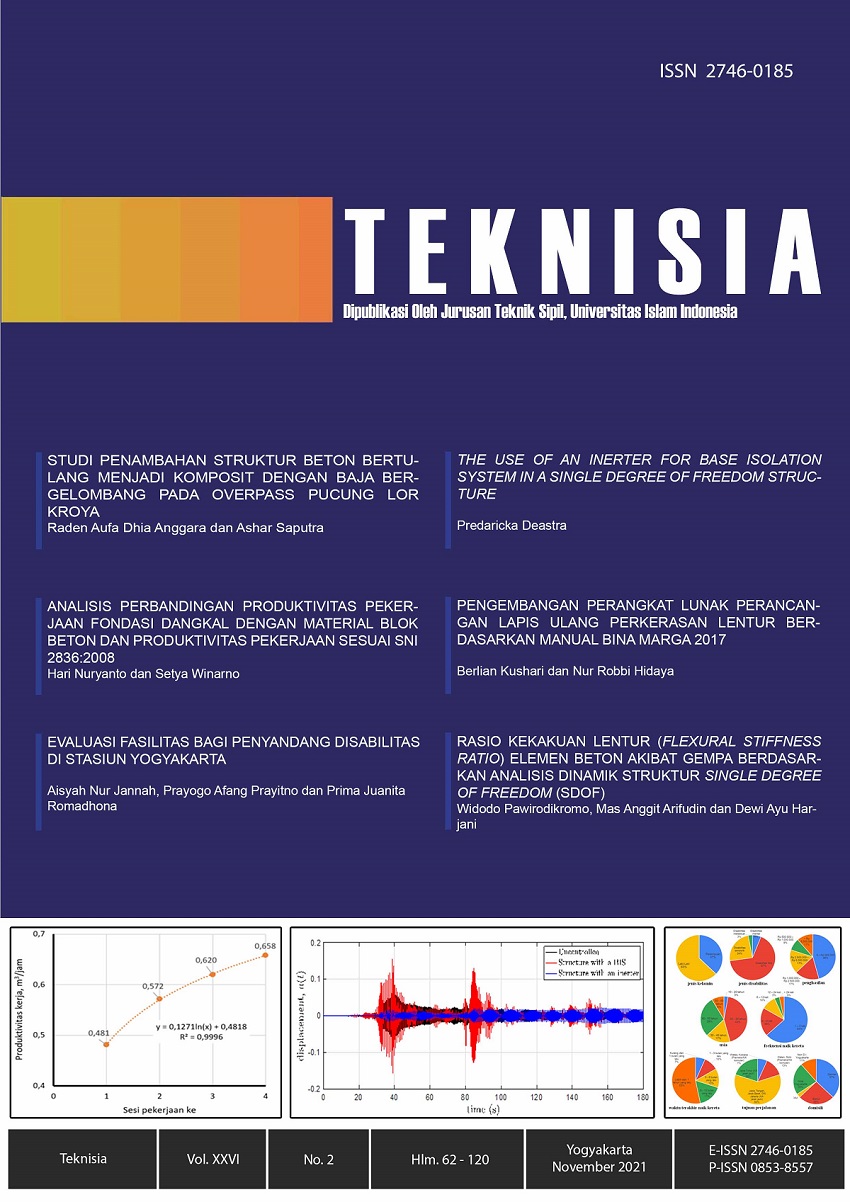Main Article Content
Abstract
Keywords
Article Details
Copyright (c) 2021 Teknisia

This work is licensed under a Creative Commons Attribution-ShareAlike 4.0 International License.
Under the following term:
-
Attribution — You must give appropriate credit, provide a link to the license, and indicate if changes were made. You may do so in any reasonable manner, but not in any way that suggests the licensor endorses you or your use.
-
ShareAlike — If you remix, transform, or build upon the material, you must distribute your contributions under the same license as the original.
- No additional restrictions — You may not apply legal terms or technological measures that legally restrict others from doing anything the license permits.
References
- Abo-Hashema, M. (2009). “Artificial Neural Network Approach for Overlay Design of Flexible Pavements”. The International Arab Journal of Information Technology, Vol. 6, No. 2, April 2009, pp. 204-212.
- Badan Standarisasi Nasional. (2011). “Cara Uji Lendutan Perkerasan Lentur Dengan Alat Benkelman Beam”. Jakarta.
- Direktorat Jenderal Bina Marga. (2017). “Manual Perkerasan Jalan. Revisi Juni 2017 Nomor 04/SE/Db/2017”. Jakarta.
- Gusmalawati, P. (2016). “Pembangunan Perangkat lunak Perencanaan Tebal Lapis Perkerasan Tambahan Metode Benkelman Beam (BB) Menggunakan Aplikasi VBA-Excel”. Tugas Akhir. Universitas Muhammadiyah Yogyakarta.
- Prakoso, R. A. (2018). “Evaluasi Kondisi Perkerasan Lentur Dengan Metode PCI Dan Metode Lendutan Balik Untuk Perbaikan”. Tugas Akhir. Universitas Islam Indonesia.
- Saltan, M., Tigdemir, M., Karasahin, M. (2002). “Artificial Neural Network Application for Flexible Pavement Thickness Modeling”. Computer Journal of Turkish Journal Engineering Environment Science, Vol. 26, No. 1, pp-243-248.
- Sarwidi. (2015). “Metode Numerik”, Edisi 1. UII Press.
- Susilo, P. (2017). “Perencanaan Tebal Lapis Tambah Perkerasan Lentur (Overlay) dengan Metode Lendutan Balik (Studi Kasus: Ruas Jalan Imogiri Barat Kec. Sewon, Kab. Bantul, DIY)”. Tugas Akhir. Universitas Muhammadiyah Yogyakarta.
- Transportation Research Board of the National Academies. (2004). “Guide for the Mechanistic-Empirical Design of New & Rehabilitated Pavement Structures”. NCHRP Project 1-37A, Washington DC.
- WASHO. (1954). “The WASHO Road Test, Part 1 – Design, Construction, and Testing Procedures”. HRB Special Report 18.
References
Abo-Hashema, M. (2009). “Artificial Neural Network Approach for Overlay Design of Flexible Pavements”. The International Arab Journal of Information Technology, Vol. 6, No. 2, April 2009, pp. 204-212.
Badan Standarisasi Nasional. (2011). “Cara Uji Lendutan Perkerasan Lentur Dengan Alat Benkelman Beam”. Jakarta.
Direktorat Jenderal Bina Marga. (2017). “Manual Perkerasan Jalan. Revisi Juni 2017 Nomor 04/SE/Db/2017”. Jakarta.
Gusmalawati, P. (2016). “Pembangunan Perangkat lunak Perencanaan Tebal Lapis Perkerasan Tambahan Metode Benkelman Beam (BB) Menggunakan Aplikasi VBA-Excel”. Tugas Akhir. Universitas Muhammadiyah Yogyakarta.
Prakoso, R. A. (2018). “Evaluasi Kondisi Perkerasan Lentur Dengan Metode PCI Dan Metode Lendutan Balik Untuk Perbaikan”. Tugas Akhir. Universitas Islam Indonesia.
Saltan, M., Tigdemir, M., Karasahin, M. (2002). “Artificial Neural Network Application for Flexible Pavement Thickness Modeling”. Computer Journal of Turkish Journal Engineering Environment Science, Vol. 26, No. 1, pp-243-248.
Sarwidi. (2015). “Metode Numerik”, Edisi 1. UII Press.
Susilo, P. (2017). “Perencanaan Tebal Lapis Tambah Perkerasan Lentur (Overlay) dengan Metode Lendutan Balik (Studi Kasus: Ruas Jalan Imogiri Barat Kec. Sewon, Kab. Bantul, DIY)”. Tugas Akhir. Universitas Muhammadiyah Yogyakarta.
Transportation Research Board of the National Academies. (2004). “Guide for the Mechanistic-Empirical Design of New & Rehabilitated Pavement Structures”. NCHRP Project 1-37A, Washington DC.
WASHO. (1954). “The WASHO Road Test, Part 1 – Design, Construction, and Testing Procedures”. HRB Special Report 18.
